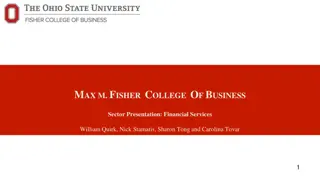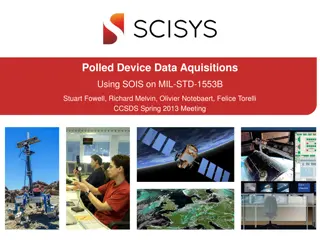Overview of Mergers and Acquisitions: Types and Examples
Explore the types of mergers and acquisitions, including mergers, acquisitions, consolidations, tender offers, acquisition of assets, and management acquisitions, with real-life examples such as Compaq and Hewlett-Packard, Manulife Financial, Citigroup, Johnson & Johnson, and more.
Download Presentation

Please find below an Image/Link to download the presentation.
The content on the website is provided AS IS for your information and personal use only. It may not be sold, licensed, or shared on other websites without obtaining consent from the author.If you encounter any issues during the download, it is possible that the publisher has removed the file from their server.
You are allowed to download the files provided on this website for personal or commercial use, subject to the condition that they are used lawfully. All files are the property of their respective owners.
The content on the website is provided AS IS for your information and personal use only. It may not be sold, licensed, or shared on other websites without obtaining consent from the author.
E N D
Presentation Transcript
Types of Mergers and Types of Mergers and Acquisitions Acquisitions
Mergers In a merger, the boards of directors for two companies approve the combination and seek shareholders' approval. For example, in 1998, a merger deal occurred between the Digital Equipment Corporation and Compaq, whereby Compaq absorbed the Digital Equipment Corporation. Compaq later merged with Hewlett-Packard in 2002. Compaq's pre-merger ticker symbol was CPQ. This was combined with Hewlett-Packard's ticker symbol (HWP) to create the current ticker symbol (HPQ).
Acquisitions In a simple acquisition, the acquiring company obtains the majority stake in the acquired firm, which does not change its name or alter its organizational structure. An example of this type of transaction is Manulife Financial Corporation's 2004 acquisition of John Hancock Financial Services, wherein both companies preserved their names and organizational structures.
Consolidations Consolidation creates a new company by combining core businesses and abandoning the old corporate structures. Stockholders of both companies must approve the consolidation, and subsequent to the approval, receive common equity shares in the new firm. For example, in 1998, Citicorp and Travelers Insurance Group announced a consolidation, which resulted in Citigroup.
Tender Offers In a tender offer, one company offers to purchase the outstanding stock of the other firm at a specific price rather than the market price. The acquiring company communicates the offer directly to the other company's shareholders, bypassing the management and board of directors. For example, in 2008, Johnson & Johnson made a tender offer to acquire Omrix Biopharmaceuticals for $438 million. The company agreed to the tender offer and the deal was settled by the end of December 2008.
Acquisition of Assets In an acquisition of assets, one company directly acquires the assets of another company. The company whose assets are being acquired must obtain approval from its shareholders. The purchase of assets is typical during bankruptcy proceedings, wherein other companies bid for various assets of the bankrupt company, which is liquidated upon the final transfer of assets to the acquiring firms.
Management Acquisitions In a management acquisition, also known as a management-led buyout (MBO), a company's executives purchase a controlling stake in another company, taking it private. These former executives often partner with a financier or former corporate officers in an effort to help fund a transaction. Such M&A transactions are typically financed disproportionately with debt, and the majority of shareholders must approve it. For example, in 2013, Dell Corporation announced that it was acquired by its founder, Michael Dell.
How Mergers Are Structured (Types) How Mergers Are Structured (Types) Horizontal merger: Two companies that are in direct competition and share the same product lines and markets. Vertical merger: A customer and company or a supplier and company. Think of an ice cream maker merging with a cone supplier. Congeneric mergers: Two businesses that serve the same consumer base in different ways, such as a TV manufacturer and a cable company. Market-extension merger: Two companies that sell the same products in different markets. Product-extension merger: Two companies selling different but related products in the same market. Conglomeration: Two companies that have no common business areas.
The various forms of acquisition are as follows: Friendly: When the acquirer and the target mutually agree on the acquisition, the transition is friendly. Hostile: If the acquirer forcefully takes over the target without the latter s consent, it becomes a hostile takeover. Buyout: Alternatively, the acquirer purchases 51% or more stocks, i.e., a controlling share in the target.
Merger and Acquisition Process: The Procedure of Merger and Acquisition Process: The Procedure of Merger Merger Companies Act 2013 provides fast-track Merger and Acquisition process. The procedure is as under: Both the transferor and transferee shall convene the Board meeting separately and pass the following resolutions: Approving the scheme. Fixing date, time and place for Shareholders Meeting. Fixing date, time and place for Creditors Meeting.
2. After holding the Board Meeting both the Transferor Company and the transferee company shall publish the notice of the proposed scheme to invite any objections or suggestions regarding the same. The copy of the notice shall be sent to the Registrar of Companies and the Official Liquidator. 3. Before convening the meeting of members and creditors, both the transferor and transferee company shall file, with the ROC of their state where their registered office has situated, a declaration of solvency.
4. A notice of a meeting of members should be given at least 21 clear days before the meeting by both the transferor and the transferee company. The notice of the meeting shall contain the following: Details of compromise and arrangement. Declaration of insolvency. Copy of scheme. The objections received shall be considered and discussed at the general meeting and will be approved by the members of both the companies.
5. After convening the meeting of members a notice of creditors shall be given at least 21 clear days before the meeting by both the transferor and transferee company. The scheme of the merger to be executed has to be approved by the creditors representing 9/10thin value. 6. The transferee company shall within seven days of the conclusion of the meeting of members file a result of a meeting of members with the Regional Director, Registrar of Companies and Official Liquidator.
7. After the scheme is filed and the Registrar and the Official Liquidator does not have any objections the Regional Director shall register the same and will give a confirmation regarding the same. If there is some kind of objection to the Registrar or Official Liquidator they shall communicate the same to the Regional Director within the period of 30 days. After the RD receives the objection by the Liquidator or Registrar and is of the opinion that the scheme is not in public interest or in the interest of creditors he shall within the period of 60days communicate the same to the tribunal and request to consider the same. If the Tribunal is of the opinion that the scheme is appropriate it shall pass the order that the procedure given in Section 232 shall be followed. The order of the tribunal should be given in writing.
8. If the scheme is approved by the Regional Director then both the transferor and the transferee company shall within the period of 30 days from the date of confirmation of the scheme file the confirmation order with the ROC where the registered office of the transferee Company is situated he shall register the same and give a confirmation letter regarding the same that confirmation letter is filed with the ROC of the Transferor Company.























